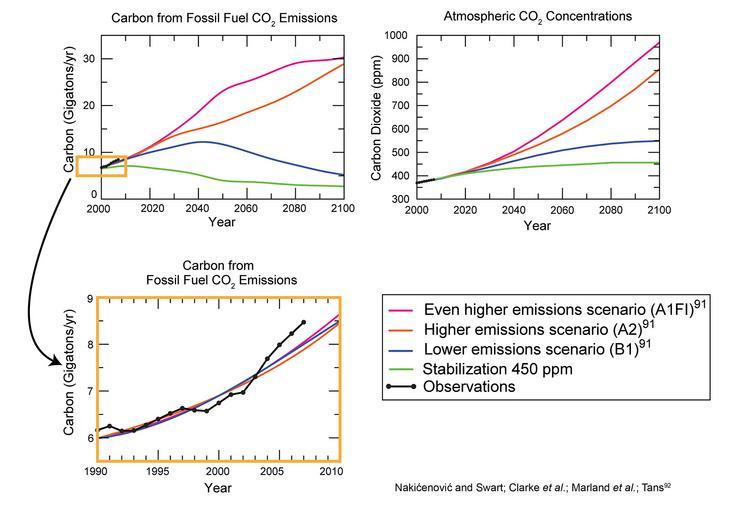MAKE A MEME
View Large Image

| View Original: | Recent_(1990-2007)_and_projected_(2000-2100)_global_emissions_of_carbon_dioxide_and_atmospheric_concentrations_under_five_emissions_scenarios_(USGCRP).png (1797x1262) | |||
| Download: | Original | Medium | Small | Thumb |
| Courtesy of: | commons.wikimedia.org | More Like This | ||
| Keywords: Recent (1990-2007) and projected (2000-2100) global emissions of carbon dioxide and atmospheric concentrations under five emissions scenarios (USGCRP).png Special Report on Emissions Scenarios for details of these storylines The graph shows projections based on three different storylines - A1FI A2 and B1 The fourth projection in the key is a stabilization scenario In the stabilization scenario emissions are reduced so that the atmospheric concentration of carbon dioxide is stabilized at 450 parts per million <br/><br/> The graph of 2000-2100 emissions projections shows baseline projections varying over time with the highest projection reaching about 25 gigatonnes per year Gt yr<sup>-1</sup> in 2050 and 30 Gt yr<sup>-1</sup> in 2100 The middle baseline projection reaches about 16 Gt yr<sup>-1</sup> in 2050 and just under 30 Gt yr<sup>-1</sup> in 2100 The lowest baseline projection reaches about 12 Gt yr<sup>-1</sup> in 2050 and about 5 Gt yr<sup>-1</sup> in 2100 The 450 ppm projection reaches about 3 Gt yr<sup>-1</sup> in 2050 and 2 5 Gt yr<sup>-1</sup> in 2100 <br/><br/> The graph of 2000-2100 atmospheric concentration projections shows baseline projections increasing at various rates over time The high baseline projection reaches about 575 ppm in 2050 and 960 ppm in 2100 The medium baseline projection reaches about 525 ppm in 2050 and 850 ppm in 2100 The low baseline projection reaches about 500 ppm in 2050 and 550 ppm in 2100 The stabilization projection reaches about 450 ppm in 2050 and remains almost stable at this level until 2100 <br/><br/> The inset expanded below the 2000-2100 emissions chart shows emissions for 1990-2010 under the three projections based on the SRES scenarios along with actual emissions to 2007 in black This inset is potentially misleading the SRES emissions projections shown in the inset are not based on the commonly used illustrative SRES scenarios Le Quéré et al 2010 To explain the IPCC selected six of the forty original SRES scenarios as illustrative of the storylines to be used for projections of climate change Projections shown in the inset however are based averages across models for A1FI A2 and B1 The averages across models for A1FI A2 and B1 are not equal to the illustrative scenarios for these storylines Le Quéré et al 2010 The inset shows that recent emissions were above all the scenario averages However emissions in one of the six illustrative SRES scenarios was higher than observed Le Quéré et al 2010 <br/><br/> References Le Quéré C et al 14 June 2010 http //www realclimate org/index php/archives/2010/06/recent-trends-in-co2-emissions/ Recent trends in CO<sub>2</sub> emissions RealClimate accessed 2011-12-04 USGCRP Karl T R et al eds http //www globalchange gov/publications/reports/scientific-assessments/us-impacts/full-report Global Climate Change in the United States http //www globalchange gov/publications/reports/scientific-assessments/us-impacts/full-report/global-climate-change Global Climate Change http //www globalchange gov/HighResImages/1-Global-pg-23 jpg Scenarios of Future Carbon Dioxide Global Emissions and Concentrations Cambridge University Press The image can also be viewed as part of the http //www globalchange gov/resources/gallery USGCRP image gallery http //www globalchange gov/resources/gallery func viewcategory catid 1 Global Climate Change Impacts in the United States http //www globalchange gov/resources/gallery func viewcategory catid 2 Chapter 1 Global Climate Change http //www globalchange gov/resources/gallery func download catid 2 id 9 Global Climate Change_9 download USGCRP 2009 From the cited USGCRP 2009 http //library globalchange gov/products/assessments/2009-national-climate-assessment/2009-global-climate-change-impacts-in-the-united-states report http //library globalchange gov/downloads/download php id 102 page 4 of PDF This report was produced by an advisory committee chartered under the Federal Advisory Committee Act for the Subcommittee on Global Change Research and at the request of the U S Government Therefore the report is in the public domain The http //www globalchange gov/resources/gallery func viewcategory catid 2 USGCRP image gallery also states The images available in the globalchange gov image gallery are not copyrighted by the USGCRP; they may therefore be used for educational instructional or personal uses as is seen fit The only exception to this rule pertains to the logos of the USGCRP and Climate Change Science Program -- these images may be used solely for the business of their respective organization <br/><br/>If any images below are used then credit must be given to the USGCRP through the form of a caption such as Image credit U S Global Change Research Program www globalchange gov In addition if the image is being used on a webpage then there must be a hyperlink directing the reader to www globalchange gov Global warming graphs Carbon dioxide PD-USGov | ||||